Cosmologists are intellectual time travelers. Looking back over billions of years, these scientists are able to trace the evolution of our Universe in astonishing detail. 13.8 billion years ago, the Big Bang occurred. Fractions of a second later, the fledgling Universe expanded exponentially during an incredibly brief period of time called inflation. Over the ensuing eons, our cosmos has grown to such an enormous size that we can no longer see the other side of it.
But how can this be? If light’s velocity marks a cosmic speed limit, how can there possibly be regions of spacetime whose photons are forever out of our reach? And even if there are, how do we know that they exist at all?
The Expanding Universe
Like everything else in physics, our Universe strives to exist in the lowest possible energy state possible. But around 10-36 seconds after the Big Bang, inflationary cosmologists believe that the cosmos found itself resting instead at a “false vacuum energy” – a low-point that wasn’t really a low-point. Seeking the true nadir of vacuum energy, over a minute fraction of a moment, the Universe is thought to have ballooned by a factor of 1050.
Since that time, our Universe has continued to expand, but at a much slower pace. We see evidence of this expansion in the light from distant objects. As photons emitted by a star or galaxy propagate across the Universe, the stretching of space causes them to lose energy. Once the photons reach us, their wavelengths have been redshifted in accordance with the distance they have traveled.
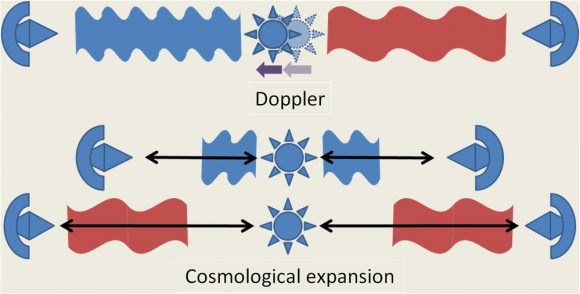
This is why cosmologists speak of redshift as a function of distance in both space and time. The light from these distant objects has been traveling for so long that, when we finally see it, we are seeing the objects as they were billions of years ago.
The Hubble Volume
Redshifted light allows us to see objects like galaxies as they existed in the distant past; but we cannot see all events that occurred in our Universe during its history. Because our cosmos is expanding, the light from some objects is simply too far away for us ever to see.
The physics of that boundary rely, in part, on a chunk of surrounding spacetime called the Hubble volume. Here on Earth, we define the Hubble volume by measuring something called the Hubble parameter (H0), a value that relates the apparent recession speed of distant objects to their redshift. It was first calculated in 1929, when Edwin Hubble discovered that faraway galaxies appeared to be moving away from us at a rate that was proportional to the redshift of their light.
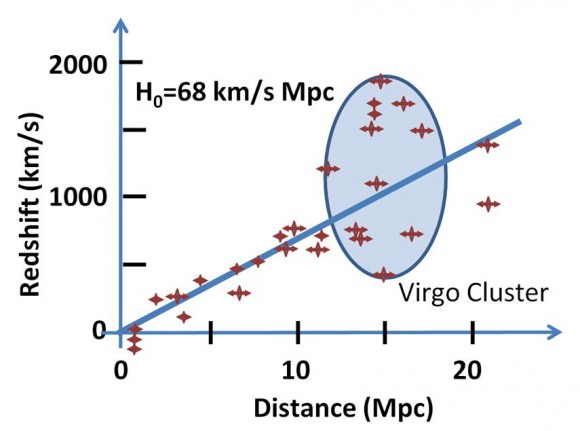
Dividing the speed of light by H0, we get the Hubble volume. This spherical bubble encloses a region where all objects move away from a central observer at speeds less than the speed of light. Correspondingly, all objects outside of the Hubble volume move away from the center faster than the speed of light.
Yes, “faster than the speed of light.” How is this possible?
The Magic of Relativity
The answer has to do with the difference between special relativity and general relativity. Special relativity requires what is called an “inertial reference frame” – more simply, a backdrop. According to this theory, the speed of light is the same when compared in all inertial reference frames. Whether an observer is sitting still on a park bench on planet Earth or zooming past Neptune in a futuristic high-velocity rocketship, the speed of light is always the same. A photon always travels away from the observer at 300,000,000 meters per second, and he or she will never catch up.
General relativity, however, describes the fabric of spacetime itself. In this theory, there is no inertial reference frame. Spacetime is not expanding with respect to anything outside of itself, so the the speed of light as a limit on its velocity doesn’t apply. Yes, galaxies outside of our Hubble sphere are receding from us faster than the speed of light. But the galaxies themselves aren’t breaking any cosmic speed limits. To an observer within one of those galaxies, nothing violates special relativity at all. It is the space in between us and those galaxies that is rapidly proliferating and stretching exponentially.
The Observable Universe
Now for the next bombshell: The Hubble volume is not the same thing as the observable Universe.
To understand this, consider that as the Universe gets older, distant light has more time to reach our detectors here on Earth. We can see objects that have accelerated beyond our current Hubble volume because the light we see today was emitted when they were within it.
Strictly speaking, our observable Universe coincides with something called the particle horizon. The particle horizon marks the distance to the farthest light that we can possibly see at this moment in time – photons that have had enough time to either remain within, or catch up to, our gently expanding Hubble sphere.
And just what is this distance? A little more than 46 billion light years in every direction – giving our observable Universe a diameter of approximately 93 billion light years, or more than 500 billion trillion miles.
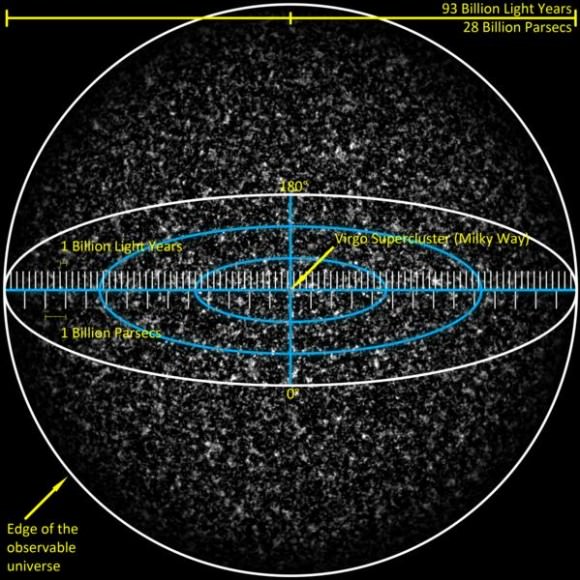
(A quick note: the particle horizon is not the same thing as the cosmological event horizon. The particle horizon encompasses all the events in the past that we can currently see. The cosmological event horizon, on the other hand, defines a distance within which a future observer will be able to see the then-ancient light our little corner of spacetime is emitting today.
In other words, the particle horizon deals with the distance to past objects whose ancient light that we can see today; the cosmological event horizon deals with the distance that our present-day light that will be able to travel as faraway regions of the Universe accelerate away from us.)
Dark Energy
Thanks to the expansion of the Universe, there are regions of the cosmos that we will never see, even if we could wait an infinite amount of time for their light to reach us. But what about those areas just beyond the reaches of our present-day Hubble volume? If that sphere is also expanding, will we ever be able to see those boundary objects?
This depends on which region is expanding faster – the Hubble volume or the parts of the Universe just outside of it. And the answer to that question depends on two things: 1) whether H0 is increasing or decreasing, and 2) whether the Universe is accelerating or decelerating. These two rates are intimately related, but they are not the same.
In fact, cosmologists believe that we are actually living at a time when H0 is decreasing; but because of dark energy, the velocity of the Universe’s expansion is increasing.
That may sound counterintuitive, but as long as H0 decreases at a slower rate than that at which the Universe’s expansion velocity is increasing, the overall movement of galaxies away from us still occurs at an accelerated pace. And at this moment in time, cosmologists believe that the Universe’s expansion will outpace the more modest growth of the Hubble volume.
So even though our Hubble volume is expanding, the influence of dark energy appears to provide a hard limit to the ever-increasing observable Universe.
Our Earthly Limitations
Cosmologists seem to have a good handle on deep questions like what our observable Universe will someday look like and how the expansion of the cosmos will change. But ultimately, scientists can only theorize the answers to questions about the future based on their present-day understanding of the Universe. Cosmological timescales are so unimaginably long that it is impossible to say much of anything concrete about how the Universe will behave in the future. Today’s models fit the current data remarkably well, but the truth is that none of us will live long enough to see whether the predictions truly match all of the outcomes.
Disappointing? Sure. But totally worth the effort to help our puny brains consider such mind-bloggling science – a reality that, as usual, is just plain stranger than fiction.

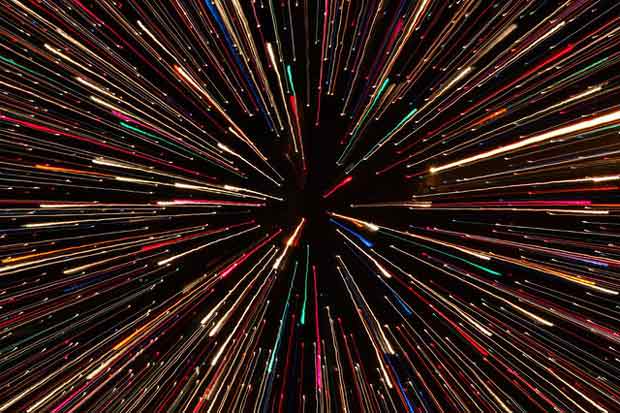
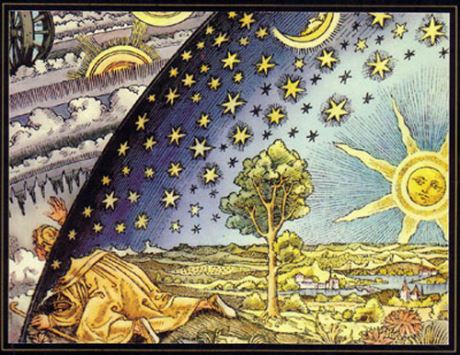
Vanessa, you’ve managed to confuse me, but after reading further on, I found that you’ve made yourself clear. Your article describes some very interesting terms – I guess people could discuss them for hours 🙂
Thanks!
One thing I’ve never understood about about this sort of thing, when cosmologists talk about the inflationary period and the universe expanding, what is the universe expanding into? I think this metaphor explains the math somewhat, but ultimately it doesn’t do the concepts justice.
Zogg from Betelgeuse has been mentioned on UT before: http://www.universetoday.com/103790/zogg-from-betelgeuse-explains-why-the-universe-has-no-edge/
Parts 1 & 2 of his episodes on the topology of the universe explain this and other thorny cosmological concepts. You’ll have to decide which concept is hardest to deal with — the concept of an infinite universe with no edges in Pt. 1, or the Pt. 2 announcement that “It doesn’t expand into anything; it just expands,” to name two — but he uses some pretty clear imagery & examples to explain them.
FTR, not saying he’s necessarily “absolutely right”, just saying the concepts are clearly and reasonably explained.
To address your statement: “. . .but the truth is that none of us will live long enough to see whether the predictions truly match all of the outcomes.”
“Everything he has made pretty in its time. Even time indefinite he has put in their heart, that mankind may never find out the work that the [true] God has made from the start to the finish.” – Ecclesiastes 3:11. Depending on the translation, the term “everlasting life” in connection what righteous humans will enjoy in the near future, appears about 140 in the Bible. The term “live forever” appears about 39 times. And the Bible states that the Earth was created and will exist for all eternity as the home of humankind.
The Bible specifically indicates that mankind was created to live forever on this earth, with perfect spiritual, moral, emotional, mental and physical health; in paradise conditions. And it is for this reason that our Creator endowed us humans with the concept of eternity …because we were created to live forever. And the Bible tells us how that processes was interrupted, and how it will be restored.
So then, yes many will live long enough to see “whether the predictions truly match all of the outcomes.” Not only that they will live to continue adding to current knowledge, as many features of creation that are know beyond our grasp, will be unfold before us throughout all eternity.
The Bible was wrote by man at a time when eternity was an unfathomable long time. Now we know the Earth is going to end. And even if it somehow survives the Sun’s expansion, is will be an uninhabitable husk. I think God showed how long the earth was to last. But it was an incomprehensible long time so the term of eternity aptly applied. Just as we now know the world is not flat, we know eternity is not in the cards for us on Earth. That does not prevent man from moving on in the cosmos. It just means that Earth won’t be our home for all of Eternity. It will be man’s birth place for all of Eternity though. That is always going to be true.
I think that the sun has a few billion years of life in it. I think that We have maybe a few. The way we are treating the earth and each other gives us a great minus. I won’t to think that another poster would be wright, but I really have my doubts. I know God, but I don’t know the mind or will of God.
Good point about the eventual end of the Earth billions of years from now when the Sun dies out. But if you believe God can create a universe then it’s very possible he can save a planet for eternity. 🙂 Who knows how that will be explained with science but it’s certainly not without possibility for an all powerful God!
But you’re forgetting that the Elder Gods (Cthulhu, Hastur, Yog-Sothoth, Shub-Nigurath, etc.), as described in H.P. Lovecraft’s works, will soon destroy the Earth while driving humanity into the darkest pits of madness. So clearly we won’t live long enough to observe the results.
You really should learn about more than just one myth!
To be utterly fair, if M_L is using the Bible to come up with the world view described above, then he/she hasn’t even learned his/her OWN ‘myth’ correctly(*), so I wouldn’t put high odds on knowing too many others with any accuracy. As always, I could be wrong, however….
*(Ps 102:25-27 and Lk 21:33, et al., for those who want references.)
Couldn’t find a “Thumbs Up” so I made one: (hopefully, it works because you truly deserve a TU!)
………..__
………./ (|
……..(___ |
……. |.._ |______
..(____) ` |
(____) |
.(____) |
..(___)_.__|_____
The stars are almost right…… 🙂
This is a science website… We deal in facts here.
Wow, I love how you wove passages and meaning from the Bible into the cosmology discussion. It just goes to show that the two topics are infinitely interesting and provide multiple angles on the human condition of creativity. Thanks for sharing.
I meant to say “curiousity” not creativity. It’s late, sorry.
Pretty well explained article but I have to point out that Hubble was not the discoverer of galactic recession, or redshift. Vesto Slipher discovered that in 1912, at Lowell Observatory, well before you credit Hubble in 1929. Slipher was also the first to observe galactic rotation. Hubble was a very good self publicist and good at using the results of others (e.g. expanding universe) to his own ends. Brilliant in his own way but a bit of a b…… 🙂
You gotta admit, though that, “The Slipher Space Telescope” doesn’t quite roll of the tongue… hehehe 😉
Einstein himself had problems with his theory of relativity because of the “spooky actions at a distance”. He realized that this most certainly indicated that C was not Vmax. This of course would invalidate the theory of relativity. He died while working on this problem.
It is becoming abundantly clear that Tesla was much more correct when he proposed that the speed of electrons was 1.67 x C. For this reason he referred to the theory of relativity was like ” a beggar in a purple robe”.
Many brilliant physicists have followed Einstein down the wrong road. This is the reason that the standard model for cosmology being in such trouble. I believe we are now obtaining radio telescope data that will invalidate the theories of black holes, neutron stars, dark matter and stellar nuclear fusion. These tenets have never been observed or experimentally confirmed. Even more important is that they require the known laws of physics and chemistry to break down. They also make no sense whatsoever.
Halton Arp’s (Max Planck Inst. and a student of Edmund Hubble) work on red shift will invalidate the theory of the big bang. Chandra findings are clearly showing that red shift is an intrinsic function of AGE, not distance or velocity. His book “Seeing Red” caused Carl Sagan to say that the findings were inconsistent with a “Big Bang”.
There is a growing body of evidence that suggest electromagnetic forces are the driving force for planet, star and galaxy formation. Anthony Peratt’s work at Los Alamos convincingly showed spiral galaxy formation from plasma. More importantly these formations had the necessary velocities so that black holes and dark matter/energy were not required. Okam’s Razor should be considered when comparing electromagnetic versus gravitational theories.
The concept of nuclear fusion within the sun is in big trouble. They have found insufficient conduction velocities to sustain this theory. The recent NASA missions to the sun have also revealed far greater complexity of the sun’s and the earth’s electromagnetic fields with significant interactions.
Donald Scott ( The Electric Sky) addressed NASA at the Goddard Engineering Colloquia in 2009. His talk was well received and is worth hearing. It is on U Tube. He made a convincing argument that the door should be opened to further evaluate the electric models of cosmology.
Quietly, NASA missions are doing this and appear to be confirming the basic tenets of these models.
Just. Stop…. You’ve made your point here over and over and over and over and over and over and over again in relentless, droning rants. OK. We get it: You know more than thousands of the best and brightest minds over the past century cumlatively do in the field of astrophysics and have successfully exposed them all for wasting their lives intentionally trying (for whatever reason) to prove a theory that OBVIOUSLY doesn’t work. You have reams of data supporting this, but for whatever reason, the people that have collected this data refuse to acknowledge any of it to the end you propose. You’re a genius and the rest of the Astrophysics (and Particle, for that matter, pun intended) communities are prideful and ignorant morons. You win. Now why don’t you just leave it at that and shut. up?
OK, I’m just going to stop reading comments on this site in articles that might have your attention so I won’t keep getting sucked into replying to you. It’s not affording me the opportunity anymore to delete it or I would, I’m sorry for insulting you and I feel like a dick. Have your opinion and I’ll have mine.
Its Ok Jeffrey – btraymd – please understand we are not ganging up on you and we commenters here have no alterior motive.. Its just that we would be excited if you could please site (contemporary) peer reviewed papers or a (contemporary) confirmed experiment or two .. some math formulas we could run inside a computer.. anything but this unsubstantiated conjecture dressed up as theory you are pushing.. You can push EU “theory” on your own youtube videos but you should expect healthy scepticism to your claims here.. Its Ok Jeffery – take a deep breath…
Uh, what? Neutron stars most definitely have been observed. Where do you get this nonsense from?
Not sure why I’m replying. Experience has shown that you are very keen to make portentous-sounding but vague and contentless claims, but you flee from any actual debate about those claims. I never did get a response to my posts showing that all of the Electric Universe predictions regarding comets Tempel 1 and Churyumov-Gerasimenko turned out to be spectacularly wrong.
If the maximum speed of an electron is 1.67c as you claim, how come nobody has been able to accelerate one to more than 1.0c?
If there is no nuclear fusion in the Sun, where are all the neutrinos coming from? Only nuclear processes can produce neutrinos. Electromagnetism cannot. So how is the Sun producing neutrinos?
Relativity speaking, Einstein’s Special Relativity is not quite right.
http://brokenelevator.weebly.com/
The site presents the information at a High School level.
It’s been proven through observations many many times and never disproven once.
Vanessa, It seems your post is confusing to readers. I think that is because your ideas need more and better explanations. For example, you cite some opinions as if they were fact when you state that “…inflationary cosmologists believe…,” as if all of them believe the cosmos “rested” during the Big Bang (BB) at a ‘false vacuum energy (level).’ How could that happen unless there was no BB at all, and you do not explain just what such energy was. You do not cite your source of the light-shift chart for us to review.
The chart requires that there is such a thing as “tired light” after all, or something similar to it, although that idea was long ago discarded. You claim that as space expands, light waves are stretched out to create the redshift effect. That requires light-wave frequency changes, but you do not explain what would cause that.
Doppler shifts occur when we or the em waves move away or toward us. It is direction of motion that causes redshifts, not the expansion of space. But please feel free to post how you arrived at your conclusion. Without a source, we each own the ideas we make up.
You sat that in GR, space-time (S-T) is not expanding. That is because the S-T Continuum does not physically exist! It is a math tool Einstein invented to prove his theories with math! Math constructs can only exist in our minds.
Please know this is not a flame. You are no different than all of us in saying that it is space that is expanding. That is because matter is not moving apart as it moves away at higher speeds. But that leaves the question, why then is space not expanding locally?
Some say it is due to the idea that expansion of space occurs faster the farther away from us, as seen in the good ‘ol bakin’ raisin dough model that has served us so well. To me, that sounds too much as if we are the center of the U, however. Everyone here seems to be afraid to respond to my ideas, but I hope you are not. Conformity is a killing field of ideas, yet the faculty we have to create them is mankind’s highest reason for being. In physics, there is no reason to fear new ideas.
The newest data from Chandra and Planck have revealed findings that put into serious doubt the theories of expansion and the big bang. They have identified quasars which are physically connected to galaxies as if being produced by the galaxies. What’s interesting is that the red shifts are very different. This provides solid evidence for the work of Halton Arp (a student of Edmund Hubble, working at the Max Planck Institute in Germany). In his book “Seeing Red’ he made a convincing case that red shift is an intrinsic function of age, not distance or velocity. This would invalidate the data used to propose both the big bang and expansion. Maybe this is why neither concept makes much sense and cannot be verified.
Good comment.
I replied and re-read your comment and had to head scratch.. AGNs and quasars have been an enigma since Arps time.. but found this on the hubble site – it might help propose an explanation..
http://www.spacetelescope.org/science/black_holes/
”
Today most astronomers believe that quasars, radio galaxies and the centres of so-called active galaxies just are different views of more or less the same phenomenon: a black hole with energetic jets beaming out from two sides. When the beam is directed towards us we see the bright lighthouse of a quasar. When the orientation of the system is different we observe it as an active galaxy or a radio galaxy. This ‘unified model’ has gained considerable support through a number of Hubble observational programs. The simplistic early ideas have however been replaced by a more complex view of this phenomenon – a view that will continue to evolve in the years to come.
I dont want my post above to come across as dismissive. Your arguments against conventional BB cosmology have some basis in logic.. As for the EU hypothesis (i am being polite giving it that label). You have not yet made any points that argue in its favour to me.. I will still listen with an open mind. In future if you want to dismantle mainstream theory and propose an alternate theory, please supply valid positive arguments citing contemporary observation and experiments and I will have more time to listen and comment..
Wow, according to the math it looks like light from the Big Bang has only covered 15% of the total diameter of the universe, meaning that 85% of the universe hasn’t even been seen yet. Is that right? Incredible!
To the author Vanessa,
I know this article has been up a while and this comment is a long way down but I am curious to get your thoughts / views if you are aware of Einsteins unpublished 1931 theory of Dynamic Equilibrium.
As mentioned here Lemaitre and Einstein independtly predicted the boundary of the universe:
http://adsabs.harvard.edu/abs/2015AAS…22521504S
For anyone curious, this youtube video discusses the theory of Dynamic Equillibrium, a theory authored independently by both Lemaitre and Einstein
http://m.youtube.com/watch?v=hWC85-zGXJI
“The redshift” is due to two simple things (and I have no idea how many complicated ones). First, movement — the old classical Doppler Effect. Second, the gravity well. What? OK, see this: http:/downshifting.weebly.com . When light travels out of a star (gravity well) it gets redshifted. Sort of like when you throw a ball up, it gets more gravitational potential energy but you lose kenetic energy. Light loses kenetic energy, not by slowing, but by redening. These are very simple concpets that I think that anyone can understand.